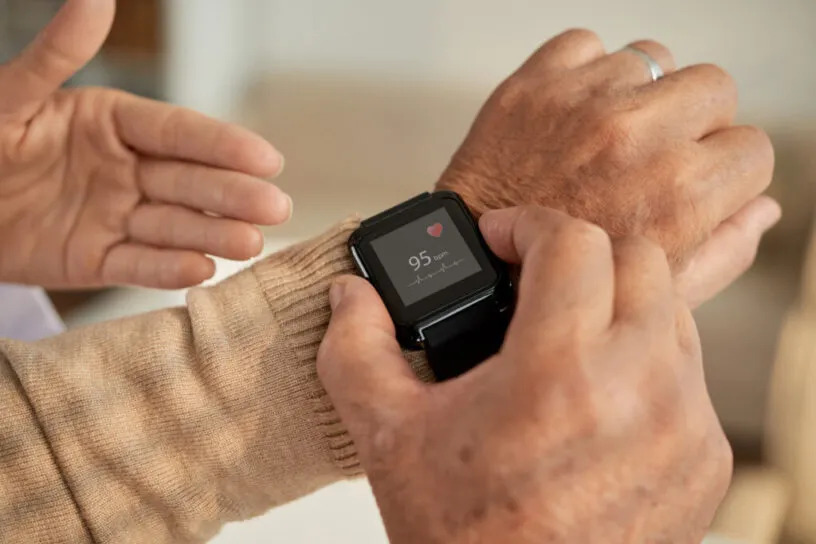What Sponsors Need to Know About Using Sensors in Decentralized Clinical Trials

When it comes to clinical trials, data is king—so it may come as little surprise that life sciences companies are always looking at ways to incorporate clinical trial technologies that increase the amount of data collected.
Wearable sensors in clinical trials, as well as other remote data capture devices, are key parts of gathering more data into trials. Not only do these clinical trial technologies allow for the collection of more data points, but they can expand access to clinical trials by making remote participation easier and less burdensome. For example, participants can make fewer trips to a central trial site if key metrics and measurements can be collected remotely.
The use of wearables in clinical trials was significant even before the COVID-19 pandemic. In 2018, management consulting firm Kaiser Associates estimated that by 2025, 70% of trials would incorporate wearables. The pandemic may have accelerated this trend toward greater use of digital health technologies since people could not reach trial sites for scheduled follow-ups.
While wearables and other mobile health devices are popular in the life sciences industry, companies would be wise to ask themselves several questions before they begin using them, according to Ben Schlatka, Vice President, Digital Biomarker Solutions, and former CEO of MC10—now a part of Medidata Solutions.
“The first questions I would ask a sponsor are: what is it you want to learn? What is the analytical question you want to ask and how can a specific device help you answer it? And perhaps most importantly, why is it important in the context of the disease and the patient population at hand?”
Schlatka notes that every sensor implementation has unique technical, operational, and analytical challenges. It’s crucial to have a proper framework in place for the use of digital health technologies before a trial begins.
“On the technical side, every device has a different way of reporting metrics, and getting that data to a place where a sponsor can use it is important,” Schlatka says. “For operational considerations, because every device is different, a sponsor has to ask: how will I implement the device globally and what are the unique patient population and regional considerations?
“Just because you can measure something doesn’t mean it’s going to be operationally easy to use,” he states. “So, you have to ask yourself: what’s the actual use case model for this sensor when it’s being worn since someone is not going to be supervising the patient directly.”
Analytical challenges can often be the most taxing for companies because many consider them to be an afterthought since they are focused solely on technical and operational challenges, Schlatka says.
“Addressing analytical challenges begins with the design of the protocol and the research questions one wants answered,” he adds. “Sponsors should ask: what research question am I trying to answer? For what patient population? And what is the best device that has the right technical and operational requirements for that particular use case?”
Earlier this year, Medidata launched Sensor Cloud—a platform to help companies manage a range of wearable sensor and digital health technology data for clinical trials. The clinical trial technology allows for continuous, real-time data collection from remote sensors on participants, including vital signs, movement, and sleep patterns.
Sensor Cloud, says Schlatka, “allows us to integrate the best medical internet of things (IoT) products in the world. We can capture data in a very organized way on a global scale for our customers and partners. They can then combine this data with other data assets in the clinical research process to get new insights specifically for patient populations and clinical research.
“Sensor Cloud solves all those organizational challenges across the best devices so you get the opportunity to use multiple devices. You get all that data back to one place, and it’s stored and organized. We organize all that disparate data in a way that lets you ask analytical questions across data platforms.”
One of the main benefits of using wearables in clinical trials is they allow for the collection of objective, repeatable, and quantifiable data throughout the day, rather than just occasionally—as is the case during traditional trial site visits.
“Perhaps the most important thing about using sensors in clinical research is that disease does not occur in a clinic,” Schlatka adds. “Disease occurs where we live, work, play, and sleep. The ability to deploy these sensors and get relevant data to understand disease progression—especially in the context of research for treatment effect—is significant.”
Schlatka sees further advancements for sensors in the future. Currently, devices embed analytics directly so you get some kind of assessment immediately. “In the future, I see a world where additional analytics and interpretation of those signals occur, in a cloud-based solution where new disease-specific algorithms can augment the on-board analytics that come with a given device.”
Schlatka is referring to the burgeoning field of software as a medical device (SaMD). “This enables researchers to use the best devices to get the best signal from the patient, but to also combine those signals with other data sets. This allows us to leverage the most current clinical research in the industry and interpret those signals in new and meaningful ways.”
Contact Us
